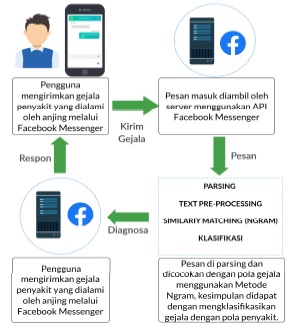Aplikasi Sistem Pakar Diagnosa Penyakit Anjing Berbasis Facebook Messenger
Abstrak
Intisari—Menjaga kesehatan hewan khususnya anjing merupakan hal yang penting, hal ini dikarenakan interaksi yang terjadi antara manusia dan anjing peliharaan sangatlah dekat. Penelitian ini membangun sistem pakar diagnosa penyakit anjing yang berguna untuk memberikan diagnosa awal terhadap suatu penyakit berdasarkan gejala yang diberikan oleh pengguna melalui Facebook Messenger. Diagnosa didapatkan dengan mengidentifikasi pola, dan mengklasifikaskan pola tersebut. Metode yang digunakan untuk mengidentifikasi pola adalah N-gram, metode ini mencocokkan kata atau karakter terhadap sebuah pola dimana jumlah karakter yang dicocokkan bisa disesuaikan. Metode yang digunakan untuk mengklasifikasikan penyakit adalah Template Matching, metode ini melakukan pencocokan antara template pola dengan pola uji untuk mencari nilai kesamaan antara pola tersebut. Penelitian ini menyimpulkan bahwa aplikasi sistem pakar dengan menggunakan metode N-gram dan Template Matching dapat bekerja dengan baik dengan tingkat akurasi sebesar 80%.
##plugins.generic.usageStats.downloads##
Referensi
[2] C. K. Kramer, S. Mehmood and R. S. Suen, “Dog Ownership and Survival : A Systematic Review and Meta-Analysis,” Circulation: Cardiovascular Quality and Outcomes, vol. 12, no. 10, 2019.
[3] C. Amiot, B. Bastian and P. Martens, “People and Companion Animals: It Takes Two to Tango,” BioScience, vol. 66, no. 7, 2016.
[4] Y. L. X. G. S. G. Tailai Wu, “A Study of Active Usage of Mobile Instant Messaging Application: An attachment theory perspective,” Information Development, vol. 33, no. 2, 2016.
[5] A. P. J. I. Indonesia, “Penetrasi & Profil Pengguna Internet Indonesia 2018,” Asosiasi Penyelenggara Jasa Internet Indonesia, Indonesia, 2018.
[6] M. A. Ali, “Artificial intelligence and natural language processing: the Arabic corpora in online translation software,” International Journal of Advanced and Applied Sciences, vol. 3, no. 9, 2016.
[7] B. Zaman, E. Hariyanti and E. Purwanti, “Sistem Deteksi Bahasa pada Dokumen menggunakan N-Gram,” Jurnal Multinetics, vol. 1, no. 2, 2015.
[8] I. F. Katili and F. D. Esabella, “Pattern Recognition Of Javanese Letter Using Template Matching Correlation Method,” Journal of Applied Intelligent System, vol. 3, no. 2, 2018.
[9] A. Wrzalik and B. Jereb, “ Use Of Expert Systems In Crisis Management,” Czoto, vol. 1, no. 1, 2019.
[10] A. M. Karim, F. V. Çelebi and A. S. Mohammed, “Software Development for Blood Disease Expert System,” Lecture Notes on Software Engineering, vol. 4, no. 3, 2016.
[11] D. Agustina, H. Mustafidah and M. R. Purbowati, “Sistem Pakar Diagnosa Penyakit Kulit Akibat Infeksi Jamur,” JUITA, vol. 4, no. 2, 2016.
[12] S. R. Joseph, H. Hlomani and K. Letsholo, “Natural Language Processing: A Review,” International Journal of Research in Engineering and Applied Sciences, vol. 6, no. 3, 2016.
[13] B. Zaman, E. Hariyanti and E. Purwanti, “Sistem Deteksi Bahasa pada Dokumen menggunakan N-Gram,” JURNAL MULTINETICS, vol. 1, no. 2, 2015.
[14] N. T. X. Huong, T.-T. Dang, T.-T. Nguyen and Anh-Cuong, “Using Large N-gram for Vietnamese Spell Checking,” Advances in Intelligent Systems and Computing, vol. 326, 2015.
[15] C. F. Tan, L. S. Wahidin, S. N. Khalil, N. Tamaldin, J. Hu and G. M. Rauterberg, “The application of expert system: A review of research and applications,” ARPN Journal of Engineering and Applied Sciences, vol. 11, no. 4, 2016.
[16] P. C. Munaiseche, D. R. Kaparang and P. T. D. Rompas, “An Expert System for Diagnosing Eye Diseases using Forward Chaining Method,” IOP Conference Series: Materials Science and Engineering, vol. 306, no. 1, 2018.
[17] N. L. Ratniasih, M. Sudarma and N. Gunantara, “ Penerapan Text Mining dalam Spam Filtering untuk Aplikasi Chat,” Majalah Ilmiah Teknologi Elektro, vol. 16, no. 3, 2017.
[18] N. G. Yudiarta, M. Sudarma and W. G. Ariastina, “Penerapan Metode Clustering Text Mining Untuk Pengelompokan Berita Pada Unstructured Textual Data,” Majalah Ilmiah Teknologi Elektro, vol. 17, no. 3, 2018.
[19] M. S. N. P. Dewa Ayu Putri Wulandari, “Pemanfaatan Big Data Media Sosial Dalam Menganalisa Kemenangan Pilkada,” Majalah Ilmiah Teknologi Elektro, vol. 18, no. 1, 2019.
[20] I. Pujadayanti, M. A. Fauzi and Y. A. Sari, “Prediksi Rating Otomatis pada Ulasan Produk Kecantikan dengan Metode Naïve Bayes dan N-gram,” Jurnal Telematika, vol. 2, no. 11, 2018.
[21] Badrinaathan.J and L.N.B.Srinivas, “Angle and Scale Invariant Template Matching for Handling Image Distortions,” International Journal of Engineering & Technology, vol. 7, no. 2, 2018.
[22] I. M. O. Widyantara, A. T. A. P. Kusuma and N. M. A. E. D. Wirastuti, “Preprocessing pada Segmentasi Citra Paru-Paru dan Jantung Menggunakan Anisotropic Diffusion Filter,” Majalah Ilmiah Teknologi Elektro, vol. 14, no. 2, 2015.
[23] K. O. Oseni, K. Dingley and P. Hart, “Instant Messaging and Social Networks — The Advantages in Online Research Methodology,” International Journal of Information and Education Technology, vol. 8, no. 1, 2018.
[24] A. Yudhana, b. Riadi and c. Anshori, “Identification of Digital Evidence Facebook Messenger on Mobile Phone With National Institute of Standards Technology (NIST) Method,” Jurnal Ilmiah KURSOR, vol. 9, no. 3, 2018.
[25] P. S. M. Suryani, L. Linawati and K. O. Saputra, “Penggunaan Metode Naïve Bayes Classifier pada Analisis Sentimen Facebook Berbahasa Indonesia,” Majalah Ilmiah Teknologi Elektro, vol. 18, no. 1, 2019.
[26] A. V. M. Association, “Disease Risks for Dogs in Social Settings,” 29 Oktober 2019. [Online]. Available: https://www.avma.org/public/PetCare/Pages/Disease-Risks-for-Dogs.aspx.


This work is licensed under a Creative Commons Attribution 4.0 International License


